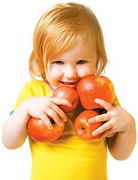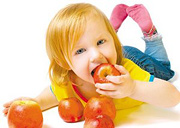How do I help my infant develop a taste for green vegetables? Give it time. Often, babies are born with a natural dislike of bitter-tasting foods, which includes most green vegetables. However, if you keep serving them the same vegetables, they might become accustomed to them and develop a taste for them. Ignore the "yucky" face. This look is a knee-jerk reaction, but studies find that most babies continue to accept spoonfuls of veggies even after making the face. Try serving vegetables along with a sweeter fruit (applesauce, pears, etc.). This might help your infant associate the sweeter taste with the appearance of the vegetable.
 When will solid foods replace milk in my baby's diet? From the age of 1, solid food will progressively replace much of the milk in your baby's diet. Try introducing a wider variety of foods, presented in an appealing way, and encourage your baby to feed themselves. Remember that young toddlers still are in the sensorimotor phase of development, and usually learn by incorporating all their senses, including smelling, touching and tasting foods. The messes simply might be part of the learning process while your toddler works at improving their motor skills.
When will solid foods replace milk in my baby's diet? From the age of 1, solid food will progressively replace much of the milk in your baby's diet. Try introducing a wider variety of foods, presented in an appealing way, and encourage your baby to feed themselves. Remember that young toddlers still are in the sensorimotor phase of development, and usually learn by incorporating all their senses, including smelling, touching and tasting foods. The messes simply might be part of the learning process while your toddler works at improving their motor skills.
What can I do with my picky toddler? They only eat sporadically and are really unpredictable in their eating habits. This is the age when many toddlers exert their independence, and one thing they can control is what they eat. After an initial year of rapid growth, toddlers can gain weight more slowly. And most toddlers always are on the go, so they don't stop for anything, including dinner! According to the FDA, toddlers between the age of 1 and 3 need approximately 1,000 to 1,300 calories per day.
 Here are a few suggestions for dealing with a picky eater:
Here are a few suggestions for dealing with a picky eater:
Give your toddler choices. You are in control and you can give them the choice of several nutritious, attractive foods. You might want to try keeping the portions small - too much food at one time may overwhelm the child.
Offer a nibble tray. You might try letting your toddler graze through an array of foods offered in an ice cube tray, a muffin tin or a compartmentalized dish. With bite-size portions of interesting foods in each section, your 2-year-old will enjoy this creative smorgasbord. Here are some suggestions for these nibbles:
- thinly sliced apples
- banana slices
- broccoli trees (steamed)
- carrot sticks (cooked and thinly sliced)
- cheese cubes
- little O's of cereal

